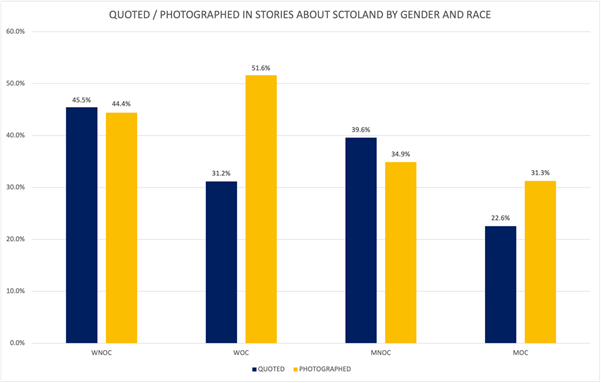Blog
#Passthemic - women of colour in stories about Scotland
by Professor Karen Boyle and Melody House at the University of Strathclyde, and Talat Yaqoob founder of Pass the Mic.
Pass the Mic is a project focusing on women of colour in Scottish news media. Initially an online database of women of colour experts, thanks to funding from the Joseph Rowntree Charitable Trust, from 2020-21 the project has expanded to undertake direct work with women of colour experts and media partners STV, The Herald, Sunday National, Daily Record, Scotsman, Courier and Holyrood magazine to challenge exclusionary cultures within news media and create a platform for the expertise of women of colour. This funding has also enabled them to undertake research to establish baseline information about where women of colour currently appear in Scottish news media in partnership with Gender Equal Media Scotland.
Read the previous blogs in the series here:
- Researching women of colour in Scottish news
- A week in Scotland's news
- Where are the women of colour in Scottish news?
- Where was Diwali in Scottish news?
Women of colour in news about Scotland
In our first period of media monitoring for Pass the Mic – from 9-15 November 2020 – we focused on where women of colour appeared across all categories of news in Scotland. In our initial report, we noted that the majority of women of colour who appeared in our news media appeared in stories which were not about Scotland. In this blog, we look in more detail at these Scottish stories.
Whilst the proportion of women of colour in all news was 3.8%, when we focused specifically on people appearing in stories about Scotland this fell to 1.6% (Table 1). It is worth noting that “stories about Scotland”, include both national and local stories. This may explain the higher proportion of “don’t knows” in Scottish stories (17%) than in our wider sample (12.3%): local stories may be more likely to include private individuals for whom identifying information is not included (e.g. “a neighbour”, “a local resident”).
Table 1: Proportion of people of colour in stories about Scotland by medium
Men not of colour Women not of colour Men of colour Women of colour Don’t know Newspaper 53.4% 25.6% 3.9% 1.2% 15.6% Web 50.6% 24.9% 3% 1.5% 19.9% Twitter 41.3% 35.3% 2.8% 2.3% 17.8% Television 53% 37.8% 5.2% 2.1% 1.9% All media 50% 27.8% 3.4% 1.6% 17%
Many of the patterns we observed in the wider sample were also borne out in the Scottish stories. For instance, people of colour in general were more likely to be photographed than quoted, and the sharpest distinction here was among women of colour (Figure 1).

Perhaps the most striking differences between where women of colour appeared in our wider sample and where they appeared in Scottish news related to occupation and function. Women of colour were concentrated in a narrower range of occupational categories in Scottish stories, appearing in only 13 of the 28 categories (whilst women not of colour appeared in 27).
The most common occupational category in Scottish stories was politician (29.8%). Unsurprisingly, given the prominence of the First Minister, men were not as heavily over-represented in the politician category in Scotland-specific news (at 54.8%) as they were in the wider sample (at 65.7%). This demonstrates the importance of political leaders to the media landscape. However, the marginalisation of women of colour was even sharper:
- only 7 women of colour politicians appeared in stories about Scotland
- women of colour made up only 0.4% of all politicians in Scottish stories
- of all women of colour in Scottish news, 7.5% were politicians.
Of course, it could be argued that this reflects current political reality in Scotland, where no women of colour have yet been elected to the Scottish Parliament. However, it is important to remember that the “politician” category includes politicians at all levels of government as well as party officials and candidates.
Women of colour were most heavily represented in the celebrity category: 38.7% of all women of colour were celebrities.
The other striking findings related to the function people fulfil in news stories. You may remember from our earlier blog that Pass the Mic is particularly interested in those functions where news organisations exercise most control in selection and so we will, again, focus here on experts and those offering personal experience and popular opinion. Although the numbers are small, in all categories, women of colour were even more marginalised in Scottish stories than in the wider sample. Most alarmingly, there were no women of colour offering popular opinion.
Table 2: Functions of people in the news about Scotland (figures from wider sample in brackets for comparison)
Men not of colour Women not of colour Men of colour Women of colour Expert 50.7% (53%) 28.7% (20%) 4% (4%) 1%(2%) Personal experience 50.1% (51%) 27.1% (38%) 3.5% (4.4%) 1.7% (4.7%) Popular opinion 48.9% (47.4%) 31.7% (24.4%) 2.2% (3.2%) 0% (1.7%)
Our second monitoring study will take place during the campaign period for the Scottish Parliament elections. In election reporting, the opinions of voters often play a prominent role. Our media partners can and should do better in including women of colour voters – as well as experts – in their coverage.
Remember, we will be watching.
Comments: 0 (Add)
In this section
Get in touch
Explore how you can contribute to our vision of a more gender-equal media and culture in Scotland by reaching out today.
Sign up to our mailing list
Sign up to receive updates on EMCC events, opportunities, and our latest reports, straight to your inbox: